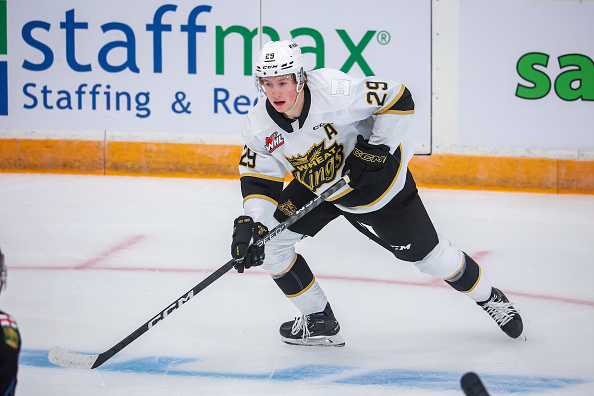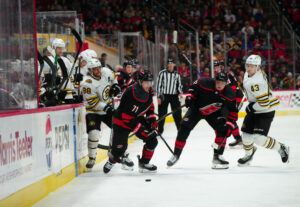Welcome back to Top Shelf Prospects, the column that brings you the next crop of professional hockey players. Each day our LWOS Prospects Writers will bring you a new player profile or topical article in the lead-up to the 2023 NHL Draft. Be sure to bookmark the site, follow Ben Kerr, Kyle Pereira and Frederik Frandson on Twitter, and spread the word for the site that will bring you analytical and critical profiles and scouting reports! Last Word On Hockey Prospects is your new headquarters for everything “NHL Draft”! Today we bring you our Nate Danielson Scouting Report.

The 2023 NHL draft class is a loaded one. From the top with Connor Bedard and Adam Fantilli, it is arguably one of the best classes in recent memory. Add to the fact that there are some intriguing names throughout the projected first round, and it’s clear this draft is also deep. One of the guys projected to go somewhere in the middle of the first round is an interesting guy to watch: Nate Danielson.
Nate Danielson Scouting Report
Danielson, born September 27th, 2004, is a center for the Brandon Wheat Kings of the WHL. Standing at 6’1” and 185 pounds, the 18-year-old from Red Deer, Alberta has good size already. As he continues growing, he’ll likely be about 6’3” and close to or over 200 pounds, something NHL general managers likely want on their teams. Danielson has played parts of the last three seasons in the WHL. Overall, he has scored 49 goals and 79 assists for 128 points in 123 games. This season, he has posted 23 goals and 33 assists for 56 points across 46 games.
With how he has performed this season, he has earned a draft ranking range, from notable sites and experts, as high as eighth and as low as 33rd. On this writer’s unreleased rankings, Danielson is ranked 22nd. Why the discrepancy in rankings?
Centre — shoots Right
Born Sep 27 2004 — Red Deer, Alberta
Height 6’2″ — Weight 185 lbs [188 cm/84 kg]
Nate Danielson Deep Dive
Danielson is ranked from the top 10 down to the early second-round range, according to Elite Prospects, by notable sites and experts. What makes him this prospect with such differing views? Well, it lands on his playing style. What exactly is this play style? Danielson is a two-way forward, and his offence is more conservative than most of the other top prospects in this class. Let’s dive into the deeper details of his game.
Danielson’s Skating
Nate Danielson is a surprisingly good skater. It’s surprising because, on the ice, he looks taller than he really is. His strides look awkward, as he is still getting used to his growing body. But despite the more mechanical issues with his stride, he has a powerful lower body. That allows him to reach a very good top speed, and quickly. Again, his first few steps are not clean, but they still feature explosiveness which is important when translating his game to a faster NHL pace.
As for his stride mechanics, he simply looks awkward. His strides are not super long. It is almost as if he cuts his strides a little smaller because he almost doesn’t realize how big he is. It’s like he forces himself to have shorter strides, sort of hopping into his next step. It takes away from his acceleration and explosiveness to a degree, but again, it does not hold him back. Lastly, he does not have a good knee or ankle bend, and it tends to impact his edges. He cannot always pull off turns without losing speed. But there are no doubts that, with NHL coaching, the mechanics can be cleaned up. On top of getting used to his body, he can very well be a Tage Thompson-esque skater. Maybe not “fast” but takes up space quickly.
Offensive Abilities
This is where scouts tend to be the most drawn apart when evaluating Danielson. He does not push the pace. He also is not the main puck distributor or the finisher on his line. Danielson does not really get very involved on offence much at even-strength. But what he does is maintain possession. Smart passes, heavy forechecking when the puck changes possession, and a willingness to battle in the dirty areas. Let’s assess where his impacts are felt, despite the limitations.
Shooting Ability
In three tracked games, Danielson shot the puck just nine times (three per game) and hit the net only three times (33.33% shots on goal). Of those nine shots, only one came at low danger. The rest were medium danger (five) or high danger (three). Only one high danger shot hit the net, and only one medium danger shot hit the net also. Effectively, most of these shots came while Danielson was either under pressure or there was no clear passing lane. Most of them were blocked by a defender. Learning to shoot more, get closer to the net, and work on putting the puck past the first layer of defence and on the net. It’ll go a long way.
Playmaking Ability
As for his passing, Danielson is always looking for a teammate. Playing more on the perimeter or in support positions, he is not always given space to make plays. Danielson also does not flash high-end offensive creativity or stickhandling. Thus, he often can’t create space on his own. That leads to him making the simple and easy plays, extending offensive zone possessions. In total, he attempted 25 passes and completed 20 of them (80% accuracy). But, of those passes, 19 were aimed at low-danger (completing 16 of them, 84%). Only three passes were aimed at high danger, and he completed two of them.
What The Numbers Tell Us
All those tracked numbers came at even strength, which is a large majority of how the game is played. Looking at the numbers, it does not tell the full story. As stated earlier, Danielson largely stays on the outside or supports teammates with the puck as an easy pass option. Also, he does not shoot the puck often, unless he has no other choices. Learning to shoot more, go to the high-danger areas a little more, and ultimately picking up the pace a bit could make him more dynamic moving forward. But, his style is simple. Slow the game down, limit mistakes, and tire out the opposition.
Not included are some micro-stats. Danielson turned the puck over in the offensive zone nine times. That includes passes that were intercepted (one) and how many times he was knocked off the puck (eight). Meanwhile, he extended offensive zone possessions, again at even strength, 16 times (13 forced turnovers, 3 keep-ins). Essentially, his role is to do the dirty work similar to a Michael Bunting or Ondrej Palat type of player.
Nate Danielson’s Transitional Abilities
When it comes to moving the puck up ice, Danielson again takes more of a back seat. For one, Danielson rarely cheats up the ice, thus he isn’t opening up very often as an outlet pass. Additionally, he usually winds up behind the puck. Again, he stays in support positions, covering up for any mistakes a teammate could make. Essentially, he does not push the pace in this area either, preferring a more conservative role in order to limit odd-man rushes against his team. That is not an issue, but he needs to get more involved in juniors than he has to at least be more efficient and fine-tune this area before trying to transition to the pros.
Diving Deeper Into The Transitional Numbers
As mentioned, Danielson is not very involved. When it comes to exiting the defensive zone, he was involved directly on 19 attempts. He managed to exit the defensive zone with control on 57.9% of them. Compared to top prospects like Bedard and Zach Benson, Danielson averages 3.6 controlled exits per game. That’s exactly one less than Benson per game (4.6) and almost four less on average than Bedard (7.3). Additionally, Bedard exited on 88% of his attempts, and Benson did so on 73.7% of his. That shows the differences between him and the top guys in this class.
Meanwhile, when entering the offensive zone, he was directly involved in 15 attempts. He gained an entry with control on 60% of them. Again, let’s compare him to the two aforementioned players. Danielson averaged three controlled entries per game. Benson averaged 10.3 per game, while Bedard was up at 13.3. Again, when looking at efficiency, Benson gained the offensive zone with control on 64.6% of his attempts, while Bedard did so on 72.7% of his. There’s that discrepancy once again.
Danielson’s Defensive Zone Play
This is where Danielson truly separates himself from the rest. His defensive game is extremely strong, especially at his age. Danielson takes full advantage of his reach and awareness in his own end. He keeps the opposition to the outside, using his frame to box them out and away from the middle. When the puck is low, he makes sure to put himself in tight to get to the puck if it comes loose. But, he doesn’t get too close where, if the puck gets to an oppositional forward, he is out of position. He’s distanced enough that all he needs is a quick adjustment and he’s in a position to defend.
Danielson utilizes an active stick to plug up passing lanes. He uses his acceleration and speed to close in on opposing forwards quickly. Sometimes, he can get caught chasing or puck-watching. But that is a relatively rare occurrence. But, the numbers show he is involved. In those three games, at even-strength, he recorded 28 defensive zone touches and turned the puck over just five times. On those turnovers, he tends to work to get the puck right back and does not lead to many chances against his team.
Nate Danielson’s Potential
Danielson is an interesting player to project. He does not have the dynamism that many of the prospects in this class possess. He also is not the most involved player. But the fact he wears a “C” for the Wheat Kings at 18 and is so mature in how he plays, general managers can look past that aspect a little more. Plain and simple, his game is projectable. Danielson projects to have an NHL frame, with strong skating abilities. His offence may never turn heads, but he is responsible and does the little things that GMs and coaches will praise.
As for an NHL comparison, there are a few that come to mind. On a recent podcast with Catfish On Ice, this writer mentioned Anthony Cirelli. But, maybe a more reasonable comparison, stylistically, is a taller Yanni Gourde. Gourde does not flash in any one area but can take on the tougher match-ups to help his team, while still providing some offence. In the meantime, he plays the role of grinding down the opponents with an energy game. Danielson can fit that same mould.
As for potential, Danielson could be a 10-15 goal-scorer, to go along with about 25-30 assists, and be about a 45-point producer at some point down the line. Again, the offence and puck-moving abilities are not yet there for him, but he does have what it takes to be a full-time NHLer, which is valuable.
Highlights
Main Photo:
Embed from Getty Images






